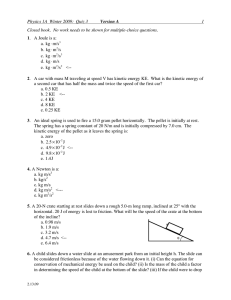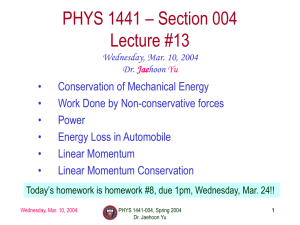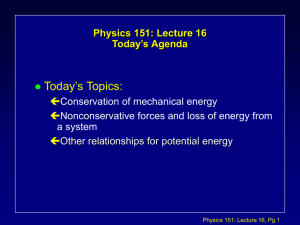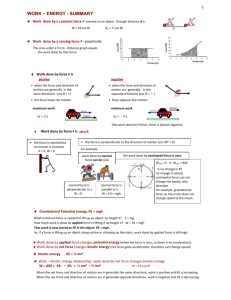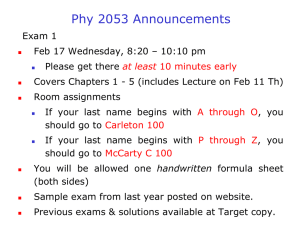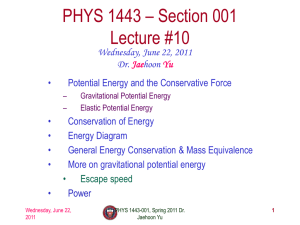Wednesday, June 30, 2004
advertisement
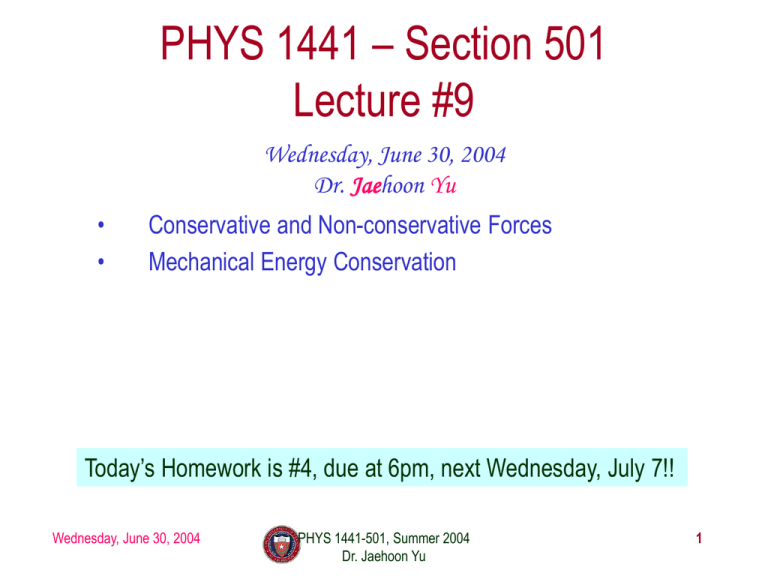
PHYS 1441 – Section 501 Lecture #9 Wednesday, June 30, 2004 Dr. Jaehoon Yu • • Conservative and Non-conservative Forces Mechanical Energy Conservation Today’s Homework is #4, due at 6pm, next Wednesday, July 7!! Wednesday, June 30, 2004 PHYS 1441-501, Summer 2004 Dr. Jaehoon Yu 1 Announcements • Term1 exam results – Average: 58.3 – Top score: 88 – Could do better… • 2nd quiz next Monday, July 5 – Beginning of the class – Sections 6.1 – whatever we cover today • 2nd term exam Monday, July 19 – Covers: Ch 6 – wherever we cover by Jul 14 Wednesday, June 30, 2004 PHYS 1441-501, Summer 2004 Dr. Jaehoon Yu 2 Conservative and Non-conservative Forces The work done on an object by the gravitational force does not depend on the object’s path. N h When directly falls, the work done on the object is l mg q Wg Fg incline l mg sin q l When sliding down the hill of length l, the work is How about if we lengthen the incline by a factor of 2, keeping the height the same?? Wg mgh Wg mg l sin q mgh Still the same amount of work Wg mgh So the work done by the gravitational force on an object is independent on the path of the object’s movements. It only depends on the difference of the object’s initial and final position in the direction of the force. The forces like gravitational or elastic forces are called conservative forces Wednesday, June 30, 2004 1. 2. If the work performed by the force does not depend on the path If the work performed on a closed path is 0. Total mechanical energy is conserved!! PHYS 1441-501, Summer 2004 Dr. Jaehoon Yu EM KEi PEi KE f PE f 3 More Conservative and Non-conservative Forces A potential energy can be associated with a conservative force A work done on a object by a conservative force is the same as the potential energy change between initial and final states Wc U i U f U The force that conserves mechanical energy. So what is a conservative force? OK. Then what is a nonconservative force? The force that does not conserve mechanical energy. The work by these forces depends on the path. Can you give me an example? Friction Why is it a non-conservative force? What happens to the mechanical energy? Because the longer the path of an object’s movement, the more work the friction forces perform on it. Kinetic energy converts to thermal energy and is not reversible. Total mechanical energy is not conserved but the total energy is stillJune conserved. in a1441-501, different form. Wednesday, 30, 2004 It just exists PHYS Summer 2004 Dr. Jaehoon Yu ET EM EOther KEi PEi KE f PE f W4 Friction Conservative Forces and Potential Energy The work done on an object by a conservative force is equal Wc U to the decrease in the potential energy of the system What else does this statement tell you? The work done by a conservative force is equal to the negative of the change of the potential energy associated with that force. Only the changes in potential energy of a system is physically meaningful!! We can rewrite the above equation in terms of potential energy U Wc U U f U i So the potential energy associated with a conservative force at any given position becomes U f x Wc Ui What can you tell from the potential energy function above? Wednesday, June 30, 2004 Potential energy function Since Ui is a constant, it only shifts the resulting Uf(x) by a constant amount. One can always change the initial potential so that Ui can be 0. PHYS 1441-501, Summer 2004 Dr. Jaehoon Yu 5 Conservation of Mechanical Energy Total mechanical energy is the sum of kinetic and potential energies m mg h m Let’s consider a brick of mass m at a height h from the ground U g mgh U U f U i v gt 1 2 1 22 So what? The brick’s kinetic energy increased K mv mg t 2 1 2 The lost potential energy is converted And? What does this mean? What is its potential energy? What happens to the energy as the brick falls to the ground? The brick gains speed h1 E K U By how much? to kinetic energy of the brick! The total mechanical energy of a system remains constant in any isolated system of objects that interacts only through conservative forces: Principle of mechanical energy conservation Wednesday, June 30, 2004 PHYS 1441-501, Summer 2004 Dr. Jaehoon Yu mg gt 2 2 mgh Ei E f Ki Ui K f U f 6 Example for Mechanical Energy Conservation A ball of mass m is dropped from a height h above the ground. Neglecting air resistance determine the speed of the ball when it is at a height y above the ground. m PE KE mgh 0 mvi2/2 mgy mv2/2 mvf2/2 mg h m Using the principle of mechanical energy conservation 1 Ki U i K f U f 0 mgh mv2 mgy 1 2 mv mg h y 2 2 v 2 g h y b) Determine the speed of the ball at y if it had initial speed vi at the time of release at the original height h. y 0 Again using the Ki U i K f U f principle of mechanical 1 2 1 energy conservation mvi mgh mv 2f mgy but with non-zero initial 2 2 1 kinetic energy!!! Reorganize m v 2f vi2 mg h y 2 terms This result look very similar to a kinematic expression, doesn’t it? Which one is it? Wednesday, June 30, 2004 PHYS 1441-501, Summer 2004 Dr. Jaehoon Yu v f vi2 2 g h y 7 Example 6.8 If the original height of the stone in the figure is y1=h=3.0m, what is the stone’s speed when it has fallen 1.0 m above the ground? Ignore air resistance. At y=3.0m 1 2 mv1 mgy1 mgh 3.0mg 2 At y=1.0m 1 2 1 2 mv2 mgy2 mv2 1.0mg 2 2 1 2 Since Mechanical mv2 1.0mg 3.0mg Energy is conserved 2 1 2 1 2 v2 2.0 g mv2 2.0mg Cancel m 2 2 Solve for v v2 4.0g 4.0 9.8 6.3m / s Wednesday, June 30, 2004 PHYS 1441-501, Summer 2004 Dr. Jaehoon Yu 8 Work Done by Non-conservative Forces Mechanical energy of a system is not conserved when any one of the forces in the system is a non-conservative force. Two kinds of non-conservative forces: Applied forces: Forces that are external to the system. These forces can take away or add energy to the system. So the mechanical energy of the system is no longer conserved. If you were to carry around a ball, the force you apply to the ball is external to the system of ball and the Earth. Therefore, you add kinetic energy to the ball-Earth system. Kinetic Friction: Internal non-conservative force that causes irreversible transformation of energy. The friction force causes the kinetic and potential energy to transfer to internal energy Wednesday, June 30, 2004 Wyou Wg K ; Wg U Wyou Wapp K U W friction K friction fk d E E f Ei K U fk d PHYS 1441-501, Summer 2004 Dr. Jaehoon Yu 9 Example for Non-Conservative Force A skier starts from rest at the top of frictionless hill whose vertical height is 20.0m and the inclination angle is 20o. Determine how far the skier can get on the snow at the bottom of the hill with a coefficient of kinetic friction between the ski and the snow is 0.210. Compute the speed at the bottom of the hill, using the mechanical energy conservation on the hill before friction starts working at the bottom Don’t we need to know mass? h=20.0m q=20o 1 2 mv 2 v 2 gh 2 9.8 20.0 19.8m / s The change of kinetic energy is the same as the work done by kinetic friction. Since we are interested in the distance the skier can get to before stopping, the friction must do as much work as the available kinetic energy. What does this mean in this problem? K K f K i f k d Since K f 0 ME mgh K i f k d ; f k d Ki Well, it turns out we don’t need to know mass. f k k n k mg 1 mv 2 Ki d 2 k mg k mg Wednesday, June 30, 2004 v2 2 k g What does this mean? 19.82 2 0.210 9.80 95.2m No matter how heavy the skier is he will get as far as anyone else has gotten. PHYS 1441-501, Summer 2004 Dr. Jaehoon Yu 10

